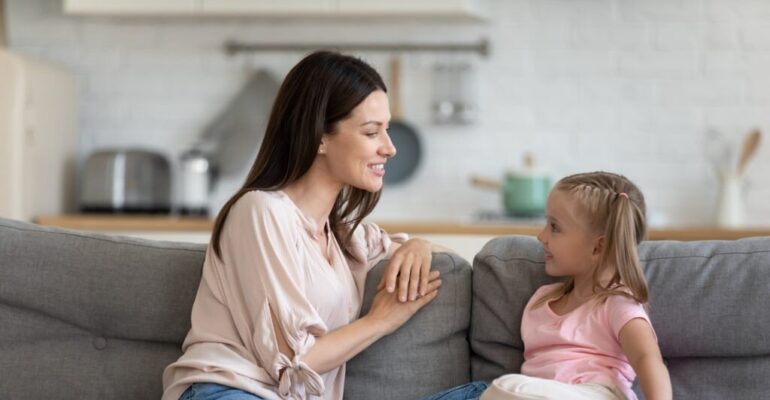 23 May 2023
23 May 2023
Constructive Conversations with Children
Anyone working with young children knows how critical the early years are to healthy child development. Every interaction we have with young children is an opportunity to make a difference in their life.
In an interview with Families Canda staff, Dr. Sebastiano Pocchi, researcher and science communicator, shares his insights on how to have constructive conversations with children, starting with active empathic listening.
Children and adults communicate in different ways. What is unique about how children communicate?
Young children, who have not yet developed verbal language, nevertheless have an innate understanding of the adult's social signals and possess a rich communicative capacity that is mainly based on the non-verbal channel.
The gestures by which they signal elements or people in the environment, as well as the facial expressions and posture that indicate their emotional reactions, are components that need attention when communicating with young children and represent pillars of their unique way of communicating, by which they can produce a very wide and surprising range of meanings.
At a less overt level, body rigidity can be a source of communication with infants, and so it becomes important to use touch to feel what they are expressing when we hold them.
Another key component of non-verbal communication in young children is proxemics, that is the distance children maintain with us during communication: even just observing that a child wants to stand adistant and explore or seeks physical proximity with us can be a huge source of information about the younger’s expressed intentions and desires.
We must also consider that their behaviors are pure communicative signals: a drawing of them can be an expression of their need; even in play we can communicate with them very effectively.
What is a strategy family support practitioners can use, to ensure they are really listening to the children they work with?
We need to start from the premise that listening is not a single skill, but is composed of three main dimensions, and therefore small adjustments can be applied to each of them.
The first dimension is sensing, the reception of the communication that children address to us. As expressed earlier, it is essential for this component to try to observe nonverbal language in its various forms and then to make use of all our sensory channels while trying not to neglect any of them.
The second dimension of processing is the one through which we try to elaborate the elements received in order to interpret the message being conveyed to us. In this dimension the advice is to never assume that we have grasped the meaning of the message right away, because misunderstandings in communication are natural and happen even among adults.
Finally, during the responding phase, we must always remember that every signal, posture, attitude, or expression we make are messages (even unconscious ones) that we send to the child and that can affect his or her propensity for social interaction with us and others.
A fourth "extra" piece of advice is not to feel guilty if at some time we fail to listen in the best way to the child. Active empathic listening (AEL) is the best way to listen to young children according to indications from multiple scientific studies and requires energy and concentration: so, it is absolutely normal that during some moments we may fail to listen appropriately. The important thing is to know AEL, spread it and try to apply it as much as possible, creating a welcoming and healthy communicative environment for children.
How does listening to children benefit society?
The research I am co-conducting with Carleton University Professor Dr Stefania Maggi (in publishing) has allowed us to survey the research literature on listening, and many studies show how it affect brain and cognitive, psychological and behavioral development of young children.
For example, applying active and empathic listening during interactions with children in their early years results in increased activation of brain areas related to language acquisition, with clear improvements in cognition, school performance, and future career prospects. This is the topic of our second webinar, "How to Have Life Changing Conversations with Young Children," which we will broadcast on May 25, 2023.
The empathy component during listening also seems essential to ensure healthy emotional development in children, leading them to develop a greater awareness of their emotions and greater ability to self-regulate.
In addition, empathic active listening also seems to have an effect in their behaviors: children are more likely to be cooperative, as well as more likely to take an interest in civic and social life.
Using empathic active listening in the family environment and other contexts, therefore, makes these environments ideal for child development; this, in the long period, can impact our society, because it gives children the opportunity to express all their talents and abilities and enables them to face the new challenges of our time, being the best version of themselves.
Want to learn more? Join Families Canada, Dr. Stefania Maggi and Dr. Sebastiano Pocchi at our new webinar series, Active Empathic Listening for Professionals. The webinar series introduces professionals who interact with young people and their families to the concept of Active Empathic Listening (AEL) and provides evidence-based information on the life-changing impact of this dimension of human communication on many aspects of a child’s development.
You won't want to miss the next 3 webinars in this 4-part series! Click on the titles below to register for the upcoming webinars.
May 25, 2023: How to Have Life Changing Conversations with Young Children
June 22, 2023: How to Nurture Empathy in Conversation with Young Children
July 27, 2023: How to Empower Young Children with Constructive Criticism




Families Canada